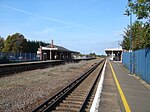Folkestone power station
Coal-fired power stations in EnglandDemolished power stations in the United Kingdom
Folkestone power station supplied electricity to the Borough of Folkestone and the surrounding area from 1898 to 1960. The power station was built by the Folkestone Electricity Supply Company Limited which operated it until the nationalisation of the British electricity industry in 1948. It was redeveloped in the 1920s to meet the increased demand for electricity.
Excerpt from the Wikipedia article Folkestone power station (License: CC BY-SA 3.0, Authors).Folkestone power station
Cheriton Road, Folkestone and Hythe District Morehall
Geographical coordinates (GPS) Address Phone number Website Nearby Places Show on map
Geographical coordinates (GPS)
| Latitude | Longitude |
|---|---|
| N 51.085555555556 ° | E 1.1513888888889 ° |
Address
Jewson
Cheriton Road
CT19 4DX Folkestone and Hythe District, Morehall
England, United Kingdom
Open on Google Maps





